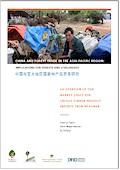| Book |
 |
|
| Title | An overview of the market chain for China | | Author | Fredrich Kahrl, Horst Weyerhaeuser and Su Yufang | | Year | 2005 | | Publisher | World Agroforestry Centre - ICRAF, SEA Regional Office | | City of Publication | Yunnan, China | | Number of Pages | 30 | | Call Number | BK0079-05 | | ISBN | 1-932928-07-3 | | Keywords | Markets, China , Timber Product, Imports, Myanmar |
|
| Abstract: |
| China’s annual timber product 1 imports from Myanmar more than tripled between 1997 and 2002 (Sun et al. 2004). Although imports from Myanmar comprise just over two percent of China’s total timber product imports, the nascent increase in logging activities along the Chinese border in Myanmar has been highly concentrated in natural forests in Myanmar’s northern Kachin State, and the ecological impacts of these activities are not captured in timber product import volumes. Growth in timber product imports coincided with China’s restrictions on domestic production in 1998, tariff reductions on forest products in 1999 and gradual relaxations on migration controls, the combination of which has considerably altered the structure of the timber industry and the face of communities along the border with Myanmar in China’s Yunnan Province.
As timber resources in northern Myanmar that can be cost-effectively harvested are rapidly depleted, there is a pressing need to develop strategies to deal with the cross-border environmental effects of prolonged, intensive logging and the livelihood implications of a diminished flow of Myanmar timber products across different segments of the market chain. The analysis is an extension of and builds upon an earlier study conducted by the authors in late 2003 (Kahrl et al. 2004). Research consisted primarily of literature reviews and semi-structured interviews. Interviews were carried out in the border towns of Pianma (Lushui County), Diantan (Tengchong County), Houqiao (Tengchong County), Yingjiang (Yingjiang County), Ruili (Ruili Municipality) and Nongdao (Ruili Municipality) and in wholesale markets in Kunming, Shanghai, and Guangdong.2 This study is fundamentally scoping in nature — facts and figures are meant to paint a picture of industry conditions across a broad range of actors and scales, rather than establish conclusive evidence concerning industry effects. Based on a more comprehensive understanding of conditions, the analysis moves on to identify priority issues along the market chain. |
|